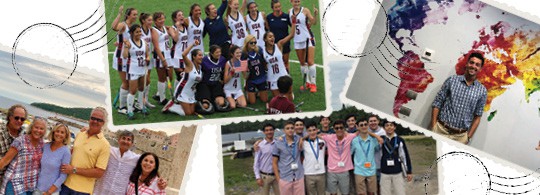Beach and ocean and exotic trips aren’t the only ways to experience summer fun. In fact, for many members of Tidewater’s Jewish community, that fun happens by incorporating something Jewish into a summer trip or activity. Within the following pages, we highlight a few such ‘Jewish Summers’ or ‘Jewish Moments.’ Even more stories are slated to appear in the September 2 issue.
Grant Campion: Internship in Tel Aviv
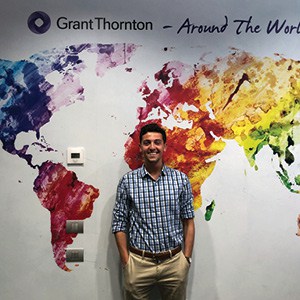 Grant Campion’s dream job is in the field of environmental law.
Grant Campion’s dream job is in the field of environmental law.
This summer, the UVa. junior took a big step to make that career path a reality and get a taste for Israeli culture. Campion used the Onward program offered on many campuses to obtain an internship that complemented his interest in corporate social responsibility (CSR). It connected him with a Tel Aviv-based sustainable consulting firm and placed him at meeting tables with clients such as Coca Cola and the Eurovision Song Contest.
The excitement of exploring Haifa, Jerusalem, and Eilat with friends, was every bit as life-changing as the sense of empowerment this work experience offered.
“I have the confidence to live overseas for two months,” says Campion. “The ability to travel to a country, live in a city, and work on my own schedule without any real guidance is very different than home or college life in the states. Being this far from my family and knowing I would be fine, is a great feeling.”
A Jewish stop in Croatia
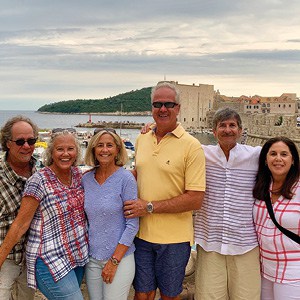
Brad and Babbi Bangel, Stephanie Calliott and Don London, and Fred and Debby Fink.
Our summer included a trip to Croatia with Babbi and Brad Bangel and Debby and Fred Fink. What a gorgeous country: sparkling turquoise waters, delicious Mediterranean food, warm welcoming people, and breathtakingly beautiful landscapes. A highlight of this special trip was a visit to the synagogue in Dubrovnik, believed to be the oldest continuous Sephardic synagogue in the world (dating back to 1546).
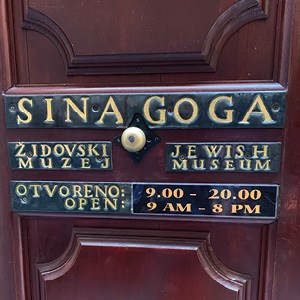
Synagogue in Dubrovnik.
Dubrovnik has an enormous and beautiful walled city (most recently adding Game of Thrones filming locations to its long list of note-worthiness) and includes stone pathways, sunset-perfect clifftop restaurants, historical churches and museums, centuries-old homes, courtyards, fountains, and flower-lined steps leading upwards toward the wall’s top. Hidden inside this magical city is the Jewish Ghetto, created in 1546 when the Dubrovnik government allocated a street with four houses to the Jews. Then, the Ghetto gates were closed each evening and reopened every morning; today, we walked freely down this narrow and short stone street. While the Ghetto wasn’t created until the 1500s, Jewish families date back to the 1400s. And, like almost every other region around the world, the Dubrovnik Jews faced a series of expulsions and persecutions, the most recent being during WWII when the Croatians were “Nazi Puppets” (as our non-Jewish guide described it). When the Italian Fascists took over the city in 1941, they established concentration camps on nearby islands—a stark contrast to the friendly people we met.
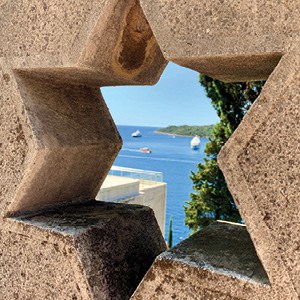
Wall with Jewish star in Dubronik.
We walked to the second floor of one of the original four houses and visited the Jewish Museum and “sinagoga” (membership 45). A lovely space, it held religious objects such as Torah scrolls (from the 13th and 17th centuries), beautifully embroidered Torah covers, silver menorahs, and tzedakah boxes. We saw copies of anti-Semitic decrees next to katubahs. Hanging from the synagogue ceiling were 20+ eternal lights (ner tamid); they were gorgeous. You see the original screens which divided the men and women, as well as the section of the building hit during the 1991 “homeland war” (they don’t call it their “civil war” as they said there was nothing civil about it). Restoration was completed in 1997, with the help of support from the local and worldwide community. The original Hebrew letters carved into the stone are still visible outside the buildings.
We each have our own memory from that visit. This is mine: When we walked into the synagogue, there was an old man seated near the top of the steps. He was someone’s grandfather, sporting a beautiful wrinkle-lined face and gray hair. Our Croatian somewhat limited, we nodded at him, reached into our wallets, and handed him some money. He paused, looked up at us, smiled, and said “Tzedakah.”
No matter where you travel, that one word, that one act, will hold us together.
Stephanie Adler Calliott
BBYO’s International Kallah impacts area teens
 In different ways, Camp Perlman was a Jewish game changer for Blake Brown, Noah Mendelson and Danial Watts. The three area BBYO teens attended International Kallah at the Lake Como, Pennsylvania B’nai B’rith camp.
In different ways, Camp Perlman was a Jewish game changer for Blake Brown, Noah Mendelson and Danial Watts. The three area BBYO teens attended International Kallah at the Lake Como, Pennsylvania B’nai B’rith camp.
After forming bonds that felt like family, Noah Mendelson didn’t want to leave, but took with him a new and deeper perspective on Israeli politics. “This was the most meaningful experience of my life. It’s going to change my ability to discuss and weigh important issues for years to come.”
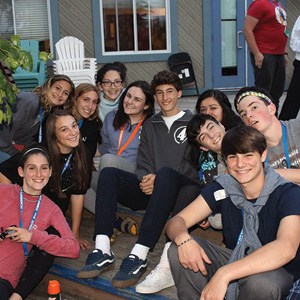 Blake Brown took advantage of daily classes on Judaism and its tenets through a series of Limmudim. This included discussing Jewish perspectives on current political issues to closely analyzing the Torah. Blake’s academic journey led to a personal discovery of his Jewish heritage through Ancestry.com. He was especially intrigued by the discovery of marriage and birth certificates of his great grandparents, and the range of countries his family originated from.
Blake Brown took advantage of daily classes on Judaism and its tenets through a series of Limmudim. This included discussing Jewish perspectives on current political issues to closely analyzing the Torah. Blake’s academic journey led to a personal discovery of his Jewish heritage through Ancestry.com. He was especially intrigued by the discovery of marriage and birth certificates of his great grandparents, and the range of countries his family originated from.
Danial Watts says “BBYO’s International Kallah at Camp Perlman was the most incredible three weeks of my life.” In this personal camp setting, Holocaust survivors spent two days and nights with campers, telling stories, asking questions, and talking about current events. Danial will never forget ‘Shabbat to Remember’ where survivors were given an Aliyah. “This was by far the most emotional and amazing thing I’ve ever experienced. Knowing I’m the last generation who will hear the stories directly from survivors themselves, is even more magical.”
International Kallah goes beyond the traditional classroom. It’s where participants find their “Jewish self” through interactive sessions and one-on-one conversations about a range of topics, making Jewish learning individualized and fun.
Lisa Richmon
Helene Schulwolf and Sadie Cohen: Bronze Maccabi winners
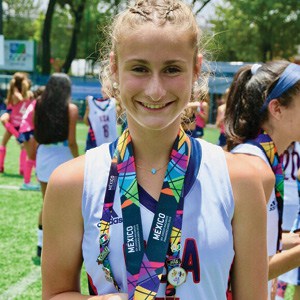
Sadie Cohen.
This summer, Helene Schulwolf, a rising sophomore at Norfolk Academy, and Sadie Cohen, a rising junior at Cox High School, took a huge step forward in their goals to play college field hockey.
Schulwolf and Cohen are childhood family friends who have been playing field hockey since elementary school, and currently play for TCOYO and Saint Hockey Rocks, respectively.
After playing separately for years, they competed together in the 14th Pan American Maccabi Games, an international, multi-sport event for Jewish athletes held every four years. More than 400 athletes from the United States participated in the competition, which featured 19 countries, 24 sports, and 2,500 participants.
The girls’ team won a bronze medal in Mexico City.
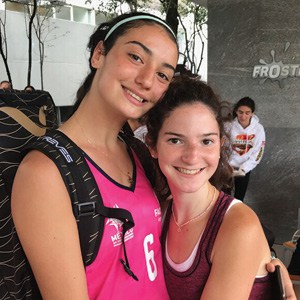
Dani Naschelski, from Argentina, and Helene Schulwolf.
“We call Maccabi ‘our mini-Olympics,’” says Schulwolf. “They have opening ceremonies and players represent their country, just like the Olympics. It was incredible watching the way the Argentinian players girls pass the ball. Their style is very similar to their national team, who are top competitors in the world of field hockey.”
“They are amazing players,” says Cohen referring to the Argentinians whose playing style she also admires. “They play differently and are more aggressive.”
Both girls had post-game epiphanies with a Jewish beat.
“Then it was time to put the game away to pray,” says Cohen. “That was really fun. All these people from different countries, who play against each other, who are also Jewish!”
Love for their sport and their Jewish heritage was a game changer for Schulwolf. Both girls attended Shabbat and Havdalah services led by a Mexican rabbi and conducted in Spanish and English.
“People from all countries came to hear prayers in English and Spanish,” says Schulwolf. “To hear the different ways the tunes and melodies sound from how we sing them here in Virginia, and in different parts of the world—how they clap in some places and stand or sit in others. It was really cool to experience this. We were swaying to the music with our arms around each other, united in song.”
Lisa Richmon

